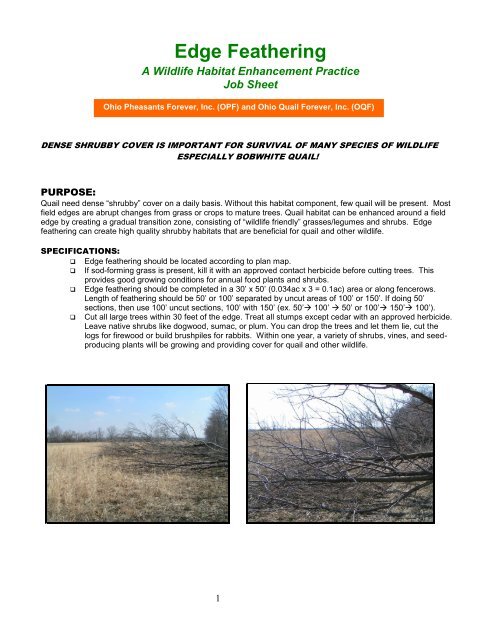Edge Feathering - Miami County Ohio Pheasants Forever
Edge Feathering - Miami County Ohio Pheasants Forever
Edge Feathering - Miami County Ohio Pheasants Forever
Create successful ePaper yourself
Turn your PDF publications into a flip-book with our unique Google optimized e-Paper software.
<strong>Edge</strong> <strong>Feathering</strong><br />
A Wildlife Habitat Enhancement Practice<br />
Job Sheet<br />
<strong>Ohio</strong> <strong>Pheasants</strong> <strong>Forever</strong>, Inc. (OPF) and <strong>Ohio</strong> Quail <strong>Forever</strong>, Inc. (OQF)<br />
DENSE SHRUBBY COVER IS IMPORTANT FOR SURVIVAL OF MANY SPECIES OF WILDLIFE<br />
ESPECIALLY BOBWHITE QUAIL!<br />
PURPOSE:<br />
Quail need dense “shrubby” cover on a daily basis. Without this habitat component, few quail will be present. Most<br />
field edges are abrupt changes from grass or crops to mature trees. Quail habitat can be enhanced around a field<br />
edge by creating a gradual transition zone, consisting of “wildlife friendly” grasses/legumes and shrubs. <strong>Edge</strong><br />
feathering can create high quality shrubby habitats that are beneficial for quail and other wildlife.<br />
SPECIFICATIONS:<br />
<strong>Edge</strong> feathering should be located according to plan map.<br />
If sod-forming grass is present, kill it with an approved contact herbicide before cutting trees. This<br />
provides good growing conditions for annual food plants and shrubs.<br />
<strong>Edge</strong> feathering should be completed in a 30’ x 50’ (0.034ac x 3 = 0.1ac) area or along fencerows.<br />
Length of feathering should be 50’ or 100’ separated by uncut areas of 100’ or 150’. If doing 50’<br />
sections, then use 100’ uncut sections, 100’ with 150’ (ex. 50’ 100’ 50’ or 100’ 150’ 100’).<br />
Cut all large trees within 30 feet of the edge. Treat all stumps except cedar with an approved herbicide.<br />
Leave native shrubs like dogwood, sumac, or plum. You can drop the trees and let them lie, cut the<br />
logs for firewood or build brushpiles for rabbits. Within one year, a variety of shrubs, vines, and seedproducing<br />
plants will be growing and providing cover for quail and other wildlife.<br />
1
MAINTENANCE:<br />
Exclude livestock from edge feathered areas.<br />
Use herbicides to suppress invasive vegetation and to control noxious weeds.<br />
PRIMARY HABITAT CONSIDERATIONS:<br />
Provide natural cover sources for bobwhite quail and other wildlife.<br />
Consult with ODOW private lands biologists or OPF/OQF biologists for recommendations on more complex sites.<br />
Contact your local ODOW office or OPF/OQF biologist for additional information on wildlife management.<br />
COMMENTS_________________________________________________________________________________<br />
___________________________________________________________________________________________<br />
___________________________________________________________________________________________<br />
___________________________________________________________________________________________<br />
___________________________________________________________________________________________<br />
___________________________________________________________________________________________<br />
___________________________________________________________________________________________<br />
___________________________________________________________________________________________<br />
___________________________________________________________________________________________<br />
___________________________________________________________________________________________<br />
LANDOWNER____________________________ Field No.________ Farm No._________ Tract No.__________<br />
ADDRESS______________________________<br />
______________________________<br />
CONTACT:<br />
_________________________<br />
_________________________<br />
DATE:_________________________<br />
2


